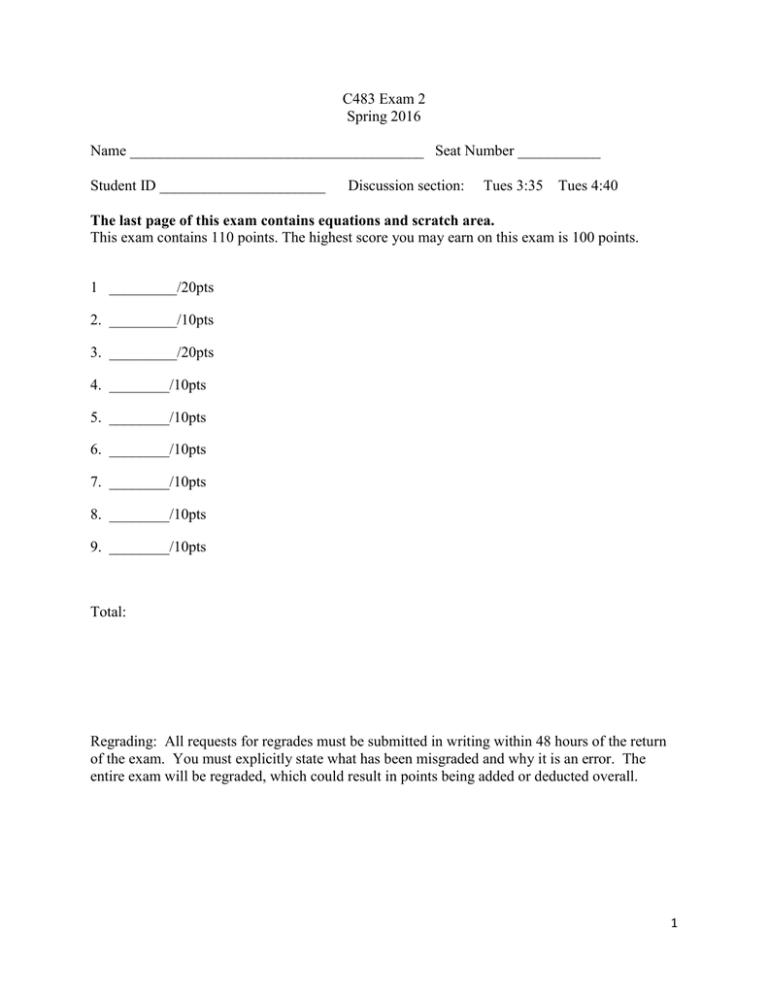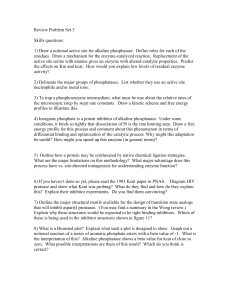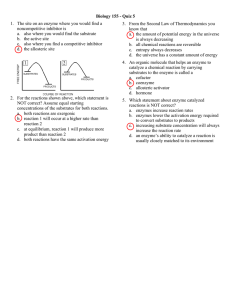C483 Exam 2 Spring 2016 Name _______________________________________ Seat Number ___________
advertisement

C483 Exam 2 Spring 2016 Name _______________________________________ Seat Number ___________ Student ID ______________________ Discussion section: Tues 3:35 Tues 4:40 The last page of this exam contains equations and scratch area. This exam contains 110 points. The highest score you may earn on this exam is 100 points. 1 _________/20pts 2. _________/10pts 3. _________/20pts 4. ________/10pts 5. ________/10pts 6. ________/10pts 7. ________/10pts 8. ________/10pts 9. ________/10pts Total: Regrading: All requests for regrades must be submitted in writing within 48 hours of the return of the exam. You must explicitly state what has been misgraded and why it is an error. The entire exam will be regraded, which could result in points being added or deducted overall. 1 Section 1: Reading guides (50 points) 1. 20 pts. Fill in the blanks (2 points each.) A. The kinetic parameter that can be used to determine whether an enzyme has reached “catalytic perfection” is ________________. B. The rectangular hyperbola of the Michaelis-Menton graph indicates that, at high substrate concentration, the enzyme becomes ________________________. C. A ________________________inhibitor is one that enters the active site and begins to react like the normal substrate, but cannot complete the reaction and gets stuck. D. Draw the structure of a 16:1 9 fatty acid below: E. The KD value of a ligand/receptor pair is the concentration of ligand at which ___________________________________________________________________. F. When two different ligands bind to two different receptors but lead to the same cellular effect, it is called ____________________________. G. ___________________________ is a type of receptor that becomes activated by autophosphorylation. H. ______________ is the reduced form of a cofactor used primarily in biosynthesis as opposed to catabolism. I. Biomolecules such as lipids and ______________________ have storage molecules in the body, but _______________ have no fuel storage forms. J. For near equilibrium reactions, changes in __________________________ can change flux through a pathway. 2 2. 10 pts. Write True or False (1 points each) A. ____________ The derivation of the Michaelis-Menton plot assumes that the velocities measured are initial rates. B. ____________ cAMP, DAG, and Protein Kinase A are common second messengers in signal transduction cascades. C. ____________ Transition state analogues typically have lower dissociation constants for an enzyme than substrate analogues do. D. ____________ Integral proteins are reversibly anchored into the membrane. E. ____________ Symport transporters require energy input, but antiport transporters are passive. F. ____________ Proteoglycans contain highly negatively charged polysaccharide chains that serve roles in connective tissue such as cartilage. G. ____________ D-ribose is an example of a ketopentose. H. ____________ NAD+ and Q are both cofactors that are electron carriers, but Q is able to accept one electron at a time, while NAD+ can only accept 2 electrons at a time. I. _____________ The reaction of 2 ADP to form AMP and ATP has a Go’ close to zero kJ/mol. J. _____________ Lateral diffusion of membrane components is relatively fast, but transverse diffusion is a slow process. 3 3. 20 pts. Short answer (5 points each) A. Give an example from the -adrenergic receptor pathway for each of the following roles: Ligand: ___________________________ Second messenger: _____________________ Kinase cascade enzyme: ___________________ transducer: _________________________ Final target protein: _________________________________ B. Calculate the free energy change for the movement of Na+ into a cell when its outside concentration is 150 mM and its cytosolic concentration is 10 mM given a temperature of 298 K and a +70 mV potential. Does sodium flow with or against its concentration gradient? C. In one sentence, how does a G-protein become activated? In one sentence, how does it become deactivated? D. Draw a graph of velocity as a function of [S] for a cooperative enzyme. On the same graph, draw a second curve of that enzyme with a negative allosteric effector added. Label each curve. 4 Section 2: Problems (10 points each) 4. A. Number the following steps of the sodium/potassium pump in order, starting with the binding of three intracellular sodium ions. __1__ Three intracellular sodium ions bind. _____ The aspartyl phosphate group is hydrolyzed and inorganic phosphate is released. _____ Two extracellular potassium ions bind. _____ ATP binds. _____The protein conformation changes, exposing the potassium binding sites to the interior. The potassium ions dissociate. _____. A phosphoryl group is transferred from ATP to an Asp side chain of the pump. ADP is released. _____ The protein conformation changes, exposing the sodium binding sites to the cell exterior. The sodium ions dissociate. B. Draw the structure of the phosphorylated Asp residue sidechain. C. Would you expect the hydrolysis of this aspartyl-phosphate group to have a large positive, small positive, near zero, small negative, or large negative Go’ value? Explain. 5 5. Draw these molecules: 6 7. A. Calculate the standard free energy for the following reaction using data from the last page of the exam. Show all work. Glucose-1-phosphate + ADP Glucose + ATP B. This reaction is not spontaneous under cellular conditions (310 K, [ADP] = 1 mM, [ATP] = 5 mM.) Based on these data, what can you conclude about the relative amounts of glucose and glucose-1-phosphate in the cell? 7 8. The tyrosinase enzyme catalyzes production of melanin in skin. Dodecyl gallate has been shown to be an inhibitor of tyrosinase. Use the Lineweaver-Burk plot below to calculate Vmax and KM for the enzyme with and without inhibitor. Show work. Vmax (no inhib) = ___________OD/min Vmax (inhib) = ___________OD/min KM (no inhib) = ___________mM KM (inhib) = ___________mM B. Does this inhibitor bind only to the free enzyme, only to the enzyme/substrate complex, or both? C. Explain why this inhibitor appears to make the enzyme have greater affinity for the substrate. 8 Section 3: Case study (10pts) Subtilisin, an alkaline serine protease, is used in detergent to help remove protein-caused stains. Protein engineers have attempted to improve its effectiveness by mutating Ile-31 to Leu-31. Crystal structures show that this residue is in close proximity to the Asp of the Asp-His-Ser catalytic triad. Both enzymes were assayed for activity using an artificial substrate that turns yellow when the peptide bond is cleaved. Enzyme KM (mM) kcat (s-1) Kcat/KM (mM-1 s-1) Ile-31 wildtype 1.9 +/- 0.2 21 +/- 4 11 Leu-31 mutant 2.0 +/- 0.3 120 +/- 5 60 A. If the [E]T used in these experiments was 1.0 x 10-9 M, draw Michaelis-Menton curves for both mutant and wild type enzymes to scale on the graph below. Label each curve. B. What effect did the mutation have on the catalytic activity of this enzyme? Comment on the KM and kcat values. C. Propose a hypothesis for how the mutation caused a change in the enzyme catalytic ability. 9 Data Tables and scratch work [𝑋]𝑖𝑛 G = RT ln[𝑋]𝑜𝑢𝑡 + ZF 𝑅𝑇 [𝑋]𝑖𝑛 ln 𝑍𝐹 [𝑋]𝑜𝑢𝑡 R = 8.314 J/ mol . K F = 96,485 J/V . mol 10


